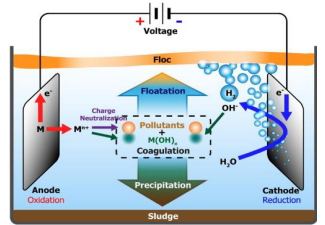Removal of Para Chlorophenol (PCP) From Wastewater Using Aluminium/Graphite Electrode by Electrochemical Method
Keywords:
Electrochemical, Para Chlorophenol, Wastewater, Aluminium ElectrodeAbstract
An experimental study was conducted to evaluate the feasibility and application of aluminum/ Graphite Electrode in electrochemical method for the removal of Parachlorophenol from Wastewater under local conditions. Removal of PCP is important issue in the world, as PCP is carcinogenic, skin sensitive, bones and lungs damage compound. A sample was prepared in laboratory, obtained 1500 ml of 200ppm p-Cholorophenol and treated in reactor in which Aluminium electrodes & Graphite Electrode installed. Added 0. 5 gm NaCl into remedy as reaction enhancer. Factors affecting on the removal of Para Chlorophenol was investigated are; varying electric voltage (10 Volts,20 volts), varying treatment time (20 Min, 60 Min) and different electrodes (Aluminium, Graphite). After treatment sample was tested by Gas Chromatography which given PCP values (0.998-0.999). it was investigated from results that removal efficiency of Para Chloro phenol increased with increasing voltage supply (20 Volts), reaction time (60 Min) and Aluminium Electrode. According to these results, the effect of Treatment time on the removal of Parachlorophenol is more than Voltage and Aluminium Electrode. Aluminium electrode efficiency is high than Graphite. When we compare Time & voltage, time & different electrodes, then removal efficiency is maximum at higher time, higher voltage and by using Aluminium electrode.
References
E. Dıaz, A.F. Mohedano, L. Calvo,M.A. Gilarranz, J.A. Casas, J.J. Rodrıguez, Hydrogenation of phenol in aqueous phase with palladium on activated carbon catalysts, Chem. Eng. J. 131 (2007) 65–71.
L. John Kennedy, J. Judith Vijaya, K. Kayalvizhi, G. Sekaran, Adsorption of phenol from aqueous solutions using mesoporous carbon prepared by two-stage process, Chem. Eng. J. 132 (2007) 279–287.
J. Huang, X. Wang, Q. Jin, Y. Liu, Y. Wang, Removal of phenol from aqueous solution by adsorption onto OTMAC-modified attapulgite, J. Environ. Manage. 84 (2007) 229–236.
O. Tepe, A.Y. Dursun, Combined effects of external mass transfer and biodegradation rates on removal of phenol by immobilized Ralstonia eutropha in a packed bed reactor, J. Hazard. Mater. 151 (2008) 9–16.
M.S.A. Palma, J.L. Paiva, M. Zilli, A. Converti, Batch phenol removal frommethyl isobutyl ketone by liquid–liquid extraction with chemical reaction, Chem. Eng. Process. 46 (2007) 764–768.
W.H. Hallenbeck, K.M. Cunningham, Quantitative Risk Assessment for Environmental and Occupational Health, Burns Lewis Publishers, 1986.
G. Annadurai, R. Juang, D.J. Lee, Microbial degradation of phenol using mixed liquors of Pseudomonas putida and activated sludge,Waste Manage. 22 (2002) 703–710.
D. Mohan, S. Chander, Single component and multi-component adsorption of phenols by activated carbons, Colloids Surf. A: Physicochem. Eng. Aspects 177 (2001) 183–196.
G. Dursun, H. C, ic,ek, A.Y. Dursun, Adsorption of phenol from aqueous solution by using carbonised beet pulp, J. Hazard. Mater. B125 (2005) 175–182.
A. Gurses, M. Yalcin, Removal of phenolic and lignin compounds from bleached kraft mill effluent by fly ash and sepiolite, Adsorption 11 (2005) 87–97.
Y. Yavuz, A.S. Koparal, Electrochemical oxidation of phenol in a parallel plate reactor using ruthenium mixed metal oxide electrode, J. Hazard. Mater. B136 (2006) 296–302.
P. Canizares, F. Martinez, J. Garcia-Gomez, C. Saez, M.A. Rodrigo, Combined electrooxidation and assisted electrochemical coagulation of aqueous phenol wastes, J. Appl. Electrochem. 32 (2002) 1241–1246.
K. Nazari, N. Esmaeili, A. Mahmoudi, H. Rahimi, A.A. Moosavi-Movahedi, Peroxidative phenol removal from aqueous solutions using activated peroxidise biocatalyst, Enzyme Microb. Technol. 41 (2007) 226–233.
H. Kuramitz, Y. Nakata, M. Kawasaki, S. Tanaka, Electrochemical oxidation of bisphenol A. Application to the removal of bisphenol A using a carbon fiber electrode, Chemosphere 45 (2001) 37–43.
K. Rajeshwar, J.G. Ibanez, G.M. Swain, Electrochemistry and the environment, J. Appl. Electrochem. (1994) 24.
L. Szpyrkowicz, J. Naumczyk, F. Zilio-Grandi, Electrochemical treatment of Tannery wastewater using Ti/Pt/Ir electrodes, Water Res. 29 (1995) 517–524.
K. Vijayaraghavan, T.K. Ramanujam, N. Balasubramanian, In situ hypochlorous acid generation for treatment of tannery wastewaters, J. Environ. Eng. 124 (1998) 887–891.
L. Szpyrkowicz, C. Juzzolino, S.N. Kaul, S. Daniele, M.D.De. Faveri, Electrochemical oxidation of dyeing baths bearing disperse Health A33 (1998) 847–862. Dyes, Ind. Eng. Chem. Res. 39 (2000) 3241–3248.
A.G. Vlyssides, C.J. Israilides, Electrochemical oxidation of a textile dye and finishing wastewater using a Pt/Ti electrode, J. Environ. Sci.
J.O’M. Bockris (Ed.), Electrochemistry of Cleaner Environments, Plenum, New York, 1972.
D. Pletcher, F. Walsh (Eds.), Industrial Electrochemistry, Chapman and Hall, London, 1990.
D. Pletcher, N.L. Weinberg, Chem. Eng. (London) (1992) Aug. 98–103, Nov. 132–141.
K. Rajeshwar, J.G. Ibanez, G.M. Swain, J. Appl. Electrochem. 24 (1994) 1077.
K. Rajeshwar, J.G. Ibanez, Fundamentals and Application in Pollution Abatement, Academic Press, San Diego, CA, 1997.
C.A.C. Sequeira (Ed.), Environmentally Oriented Electrochemistry, Elsevier, Amsterdam 1994.
P. Tatapudi, J.M. Fenton, in: H. Gerischer, C.W. Tobias (Eds.), Advances in Electrochemical Science and Engineering, vol. 4, VCH Verlagsgesellschaft, Weinheim, 1995, p. 363.
D. Simonson, Chem. Soc. Rev. 26 (1997) 181.
M. Carmona, M. Khemis, J. Leclerc, F. Lapicque, A simple model to predict the removal of oil suspensions from water using the electrocoagulation technique, Chem. Eng. Sci. 61 (2006) 1237–1246.
A.E. Yilmaz, R. Boncukcuoglu, M.M. Kocakerim, B. Keskinler, The investigation of parameters affecting boron removal by electrocoagulationmethod, J. Hazard. Mater. B125 (2005) 160–165.
M. Kobya, E. Demirbas, O.T. Can, M. Bayramoglu, Treatment of levafix orange textile dye solution by electrocoagulation, J. Hazard. Mater. B132 (2006) 183–188.
M. Bayramoglu, O.T. Can, M. Kobya, M. Sozbir, Operating cost analysis of electrocoagulation of textile dye wastewater, Sep. Purif. Technol. 37 (2004) 117–125.

Downloads
Published
How to Cite
Issue
Section
License
Copyright (c) 2024 S. Abbas

This work is licensed under a Creative Commons Attribution 4.0 International License.
Authors contributing to this journal agree to publish their articles under the Creative Commons Attribution 4.0 International License, allowing third parties to share their work (copy, distribute, transmit) and to adapt it, under the condition that the authors are given credit and that in the event of reuse or distribution, the terms of this license are made clear.





